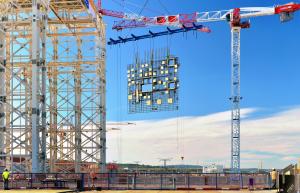It's a bird...it's a plate...
2 Nov 2015
All kinds of equipment—magnet feeders, cooling water system tanks, diagnostic systems, cryolines, cable trays—need to be attached to the walls, floors and ceilings of the Tokamak Complex.
But for structural reasons, as well as for nuclear confinement, you can't drill holes to attach pegs, hooks or shelves in a nuclear building.
The solution comes in the form of embedded plates that are welded deep into the rebar lattice and are capable of supporting loads of up to 90 metric tons in pure traction (for the largest of them).
All in all, 80,000 embedded plates are planned in the Tokamak Complex. In some cases, they can be pre-installed in the reinforcement "cages" and welded with utmost precision once the cage is in its final position on the building site.
This picture captures the spectacular "flight" of a reinforcement cage as it is lifted from the prefabrication area to be delivered to the workers responsible for the Tritium Building area, on the northeast side of the Tokamak Complex.


